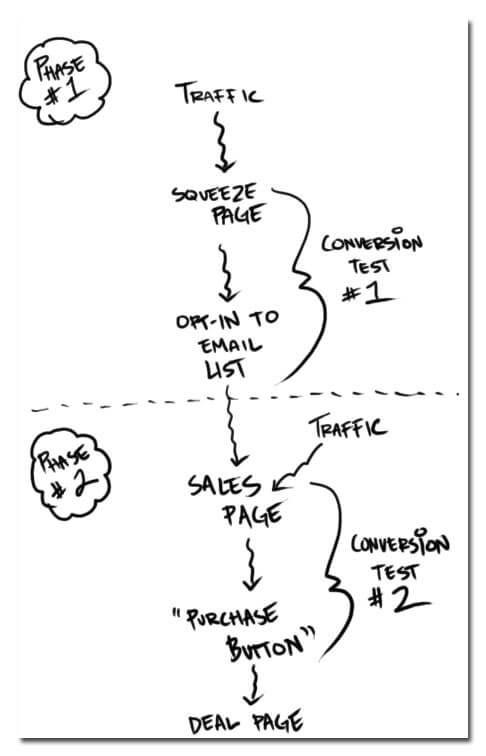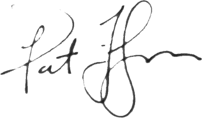This is the final part of the 4 part “How to Test Your Online Product Before It’s Even Made” series.
In Part 1, we discovered how to know if a market even exists for our product idea. In Part 2, we learned how to figure out the benefits of our product and learned about the two-phase sales process. In Part 3, we learned about how to setup a squeeze page to capture leads to test our product, and here in Part 4 we’ll be tackling how we can use a sales page to get even more defined results from our tests, all before we have a product actually made.
To recap, here’s an illustration that shows exactly what we’re up to:

I love my pen and tablet
Anyways, as you can see, we’re basically conducting two tests based on the two-phase sales process. If we don’t see a notable conversion rate for conversion test #1 (people entering the squeeze page vs. opting in to our email list), then we have a good indicator that we may not have a winning product. Of course, several versions of the squeeze page should be tested, but if we end up with a dead idea at this point, we’ve at least saved a lot of time by not spending months creating a product that may have never sold.
And If You Do See Some Conversions
If you do begin to see people opt-ing in to your email list, awesome. People are interested. You now have a couple of options:
- You can begin to create the product. You now have something that tells you that your product idea matches some people’s interest, and also that you’re able to reach your target market too. Use the motivation you’ve gained by people opt-ing into your list to crank it out as soon as you can. Furthermore, you may want to utilize some of the people on your email list to help create the product itself to ensure that you’re building it in a way the appeals to your target market. Make sure you somehow reward the people that do help you out.
- You can continue by testing Phase 2. More on this below…
Step 4: The Sales Page Test
For some of you, a converting email list will be enough proof for you to pull the trigger and begin creating your product. However, for others, it may not be enough. As I previously mentioned in part 2:
“Your market can tell you exactly what they want. Your market can go even further to tell you that they would give you money for something you plan to offer. The brutal reality is that when the time comes to actually pay you, when it’s time for your market to pull out their wallets and enter their credit card information online, your market’s word means nothing.”
For those of you who want more…
In conversion test #2, we’re going to take our traffic through the exact same process they would be going through if they were actually buying a product us, via a sales page. By tracking to see how many people end up clicking the “buy now” or “add to cart” buttons, we can see exactly how many people would of taken out their wallets and paid.
When you do end up with conversions at this stage, you’d better get your product created NOW, because there are people waiting to pay you for it. All the more motivation to get it done
So, how does it work?
Here’s the trick:
When people click the “buy now” button, or “add to cart” button, it doesn’t send them to a page where they fill out their billing information. We don’t have an actual product yet, so why would we?
Rather, it sends them to a page that tells them that the product is currently unavailable. We can track how many people reach this page through a conversion funnel in Google Analytics, or any other website tracking tool that you’re used to. If you’re using Google Optimizer to test different versions of your sales page (as you should be), then that will keep track of the conversions for you as well.
This is the best way to test if people would actually pay you for a product without actually having a product.
But, that’s not cool!
You may be thinking that it’s kind of mischievous to offer a product to someone and then tell them it’s unavailable. Well, don’t worry because this happens all of the time. Have you ever tried to buy something, only to see that it’s on back-order or sold out? I have, but I don’t remember when and where that happened.
Now, have you ever been offered a special bonus or discount on the product because it wasn’t available? Probably not, but that’s exactly what we’re going to do. Here’s why:
- We should give the people that reach this point something because they were kind enough to be a part of our little test. We don’t tell them that, but they’ll be happy to receive a discount on the product in the future once it’s created.
- These people are highly targeted customers. They already proved to us that they want to pay, so we better make sure we get them back here once our product is ready.
- It will decrease the chances of people changing their minds when your product does become available.
- It may also help to gather some buzz for your product. Traffic that reaches this point may inform others about the special bonus or discount offer for trying to get the product early.
We can offer a discount by showing them a coupon code that they will need to enter into the shopping cart once the product does become available, but there’s an even better way:
We can have an opt-in form for a separate email list on this page that you can use to contact these people directly. Aside from being a way to ensure the people who reach your “deal page” get the discount code, you can use your email list to let them know exactly when your product is available.
The Sales Page
Unfortunately, the topic of the sales page is far too big to include in this post. I plan to write a blog post in the near future about the sales page, but I definitely recommend hiring a copywriter, or using the sample sales page from Yanik Silver’s Moonlighting on the Internet book [This link leads to Amazon. Full disclosure: I earn a commission if you purchase through this link] , which I did have some success with myself.
That being said, I hope you understand the objective of using this method, and how it can really show us how successful a product idea can be without actually having the product created.
No Conversions?
If you’ve setup your sales page, sending traffic to it from your blog, from social media, and your existing email list, but you aren’t converting, there may be a few things going on:
- Your sales page isn’t structured properly. You may want to ask people to read it for you and give you feedback, or look into hiring someone to optimize it for you if you haven’t yet.
- Your tracking may not be setup correctly. It’s a fairly common issue, which I’ve actually experienced myself. Double and triple check your tracking codes and tools to make sure the data your getting is accurate. You may want to ask a couple friends to go through the process for you so you can see if your tools are picking them up.
- You just may not have a good enough offer. You know people are interested (based on conversion test #1), but maybe your price is too high, or your bonuses aren’t convincing, or your product just doesn’t have enough value. At this point, you may want to hit your existing email list with a survey. You know you’ve sent them to your sales page already, so you can use a survey service like SurveyMonkey.com to conduct an anonymous survey with your list to see exactly where you’re going wrong. (In the settings in Aweber, you can set it up so that people who do reach your “deal page” and opt-in for the discount code get automatically taken off this original list. You don’t want to ask the people who did click on the “buy now” buttons why they weren’t interested, when in fact they were).
In my opinion, if you’re got interest on your squeeze page, you should be able to convert them into sales. What’s nice is that if you do see conversions on your sales page, you not only have some crazy motivation to start and finish creating your product, but your squeeze page and sales page are already finished and proven to work!
Cheers!
I hope you have enjoyed this series. I know there are a few holes, such as the sales page itself, which I do plan to address later, but I hope you can now see that it is possible to test your product ideas before you actually invest a significant amount of time to it.
Thank you all for your wonderful comments and inspiration, as well as the birthday wishes! I just turned 27 yesterday, but wanted to make sure I finished this post for you today.
Lastly, if you have yet to subscribe to the blog, you can do so by clicking here.
I wish you nothing less than success.





